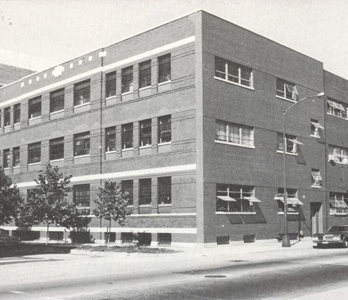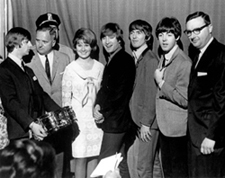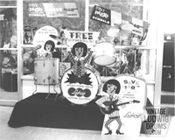
 Ludwig innovation exists as forerunners to modern drum manufacturing. Driven by passion for the drum industry, brothers William F. and Theobald Ludwig would bring to life concepts and ideas of snares, drums, hardware, and accessories. It leads to an extraordinary impact, reaching a pinnacle in the 1960’s. The success of it all was very simple...just drummers making products for drummers. It can easily be argued that Ludwig either directly, or indirectly helped shape both music and modern drum manufacturing for decades to come.
Ludwig innovation exists as forerunners to modern drum manufacturing. Driven by passion for the drum industry, brothers William F. and Theobald Ludwig would bring to life concepts and ideas of snares, drums, hardware, and accessories. It leads to an extraordinary impact, reaching a pinnacle in the 1960’s. The success of it all was very simple...just drummers making products for drummers. It can easily be argued that Ludwig either directly, or indirectly helped shape both music and modern drum manufacturing for decades to come. It starts in Chicago, IL, year 1909. An idea for the first American made floor foot pedal came to production through brothers William F. and Theobald Ludwig. This new product was well received by the industry, resulting in high regard for the newly established brand, Ludwig & Ludwig. Soon thereafter, Ludwig & Ludwig would design, distribute, and manufacture all things drums and percussion: snares, bass drums, drum heads, hardware, and into the evolved trap kit. After the death of Theobald in 1918, William F. was determined to carry on the business that he'd established. William F. would do everything possible to remain a prominent figure in the drum and percussion industry. Ludwig & Ludwig would thrive throughout the 1920’s offering fresh innovative drum products that would later become the foundation to the legacy established today.
It starts in Chicago, IL, year 1909. An idea for the first American made floor foot pedal came to production through brothers William F. and Theobald Ludwig. This new product was well received by the industry, resulting in high regard for the newly established brand, Ludwig & Ludwig. Soon thereafter, Ludwig & Ludwig would design, distribute, and manufacture all things drums and percussion: snares, bass drums, drum heads, hardware, and into the evolved trap kit. After the death of Theobald in 1918, William F. was determined to carry on the business that he'd established. William F. would do everything possible to remain a prominent figure in the drum and percussion industry. Ludwig & Ludwig would thrive throughout the 1920’s offering fresh innovative drum products that would later become the foundation to the legacy established today.Socioeconomic issues in the first half of the 20th century presented numerous difficulties for the Ludwig brand to remain as a profitable business. This would result in the selling of the company to C.G Conn in 1929. Ludwig Drums was now part of a merger with Leedy Drums under C.G Conn, known as Leedy and Ludwig. William F. would work for C.G Conn up until 1936. Unable to reconcile his feeling about drum production and management, William F. would leave C.G Conn and start the business all over again. The WFL Drum Co. would come to rise, as C.G CONN owned the “Ludwig” name. It was under the WFL era where many more concepts to modern drum manufacturing were birthed. By 1960, these concepts, amongst others, would reach a pinnacle under the re-acquired, Ludwig Drum Co.
The 1960’s became the decade of the Ludwig manufacturing boom. Newly branded and established as the Ludwig Drum Co, no longer WFL, a concept formulated early on would shape the sound of music to come...the concept of the 3-ply shell. It was the design of 3ply classic shells, wrapped in stunning décor, which left a lasting impression on drummers for years to come. The 3-ply shells were available in several variants and outfits to satisfy amateur and pro drummers alike. Shells were crafted from a mold consisting of 3 individual plies of varying woods, with a single solid reinforcement ring on each end of the drum shell.
 The design and tone of Classic Shells would be showcased on the Ed Sullivan show in 1964 by The Beatles drummer Ringo Starr, changing Ludwig drums forever. It was a Ludwig classic shell Downbeat model in Black Oyster Pearl finish, played by Ringo Starr, supporting and moving the string arrangement and vocal melodies of John Lennon, Paul McCartney, and George Harrison. William F. Ludwig Jr., president of the company, would often joke that the Beatles appearance on the Ed Sullivan Show was “the show that launched one thousand orders.”
The design and tone of Classic Shells would be showcased on the Ed Sullivan show in 1964 by The Beatles drummer Ringo Starr, changing Ludwig drums forever. It was a Ludwig classic shell Downbeat model in Black Oyster Pearl finish, played by Ringo Starr, supporting and moving the string arrangement and vocal melodies of John Lennon, Paul McCartney, and George Harrison. William F. Ludwig Jr., president of the company, would often joke that the Beatles appearance on the Ed Sullivan Show was “the show that launched one thousand orders.” For the next few years, Ludwig Drum Co. struggled to keep up with the demand for their products. For three years the company only closed on 3 holidays: Christmas, Thanksgiving and New Year's. The company’s sales more than doubled in two years from 6.1 million to 13.1 million dollars. Ludwig drums were in such high in demand that proper lumber for classic shell molds were becoming scarce. Ludwig was forced to buy different types of wood to mold shells resulting in a variance in shell makeup for some time. From this point forward, the Ludwig name will became synonymous with drummers. In every studio and on every stage, there was a Ludwig drum.
For the next few years, Ludwig Drum Co. struggled to keep up with the demand for their products. For three years the company only closed on 3 holidays: Christmas, Thanksgiving and New Year's. The company’s sales more than doubled in two years from 6.1 million to 13.1 million dollars. Ludwig drums were in such high in demand that proper lumber for classic shell molds were becoming scarce. Ludwig was forced to buy different types of wood to mold shells resulting in a variance in shell makeup for some time. From this point forward, the Ludwig name will became synonymous with drummers. In every studio and on every stage, there was a Ludwig drum.